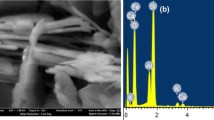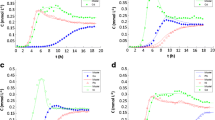Abstract
Various studies have been defined on contaminants removal from soil, recently. This reflects the attention of researchers to environmental problems. The CuO nanoadsorbent has been used in this research. In this work, the effect of effective variables such as pollutants initial concentration, contact time and pH on adsorption is investigated, experimentally. Results show that removal of benzene and toluene is maximum at concentrations 6.3 and 6.9, respectively. Results show that maximum adsorption of benzene and toluene which occurs at pH is 9.7 and 5.6, respectively. This research shows the optimum contact time is 90 min. Results show that adsorption is a reversible process and follows ion exchange mechanism. In addition, this study show that adsorption equilibrium data of benzene and toluene follow quadratic kinetic model and intra-particle diffusion model, respectively.







Similar content being viewed by others
Availability of data and material
Not applicable.
Code availability
Not applicable.
References
Behera ID, Nayak M, Biswas S, Meikap BC, Sen R (2021) Enhanced biodegradation of total petroleum hydrocarbons by implementing a novel two-step bioaugmentation strategy using indigenous bacterial consortium. J Environ Manag 292:112746
Behera ID, Nayak M, Mishra A, Meikap BC, Sen R (2022) Strategic implementation of integrated bioaugmentation and biostimulation for efficient mitigation of petroleum hydrocarbon pollutants from terrestrial and aquatic environment. Mar Poll Bull 177:113492
Moodley P-P, Lokhat D, Ahmad A, Mishra A, Meikap BC (2022) Kinetic studies on the potential use of citrus-based green and low-cost demulsifying agents for the oil-in-water emulsions’ treatment. J Environ Chem Eng 10(1):107127
Onyenechere EC, Uwazie UI, Elenwo EI, Ibe FC (2022) The urban informal sector’s activities and its influence on soil and water quality of some Southern Nigerian Cities. Sci Afr 15:e01077
Zarei A, Farahbod F (2017) Empirical investigation of performance of nano bed for industrial wastewater treating. SCIREA J Chem Eng 2:1–9
Dorostkar B, Farahbod F (2017) Empirical investigation of treatment process of outlet wastewater from petroleum industries. J Appl Biotechnol Bioeng 2(5):00045
Lin S, Chen XW, Cai Z, Shi J, Fu J, Jiang G, Wong MH (2022) Remediation of emerging contaminated sites due to uncontrolled e-waste recycling. Chem Eng J 430(4):133169
Farahbod F (2021) Experimental investigation of thermo-physical properties of drilling fluid integrated with nanoparticles: improvement of drilling operation performance. Powder Technol 384:125–131
Farahbod F (2020) Mathematical investigation of diffusion and decomposition of pollutants as a basic issue in water stream pollution. Arab J Geosci 13(18):1–9
Mahdia S, Razika K, Nadji M-M, Abdellah I (2022) Decontamination of soil polluted by hydrocarbons. Mater Proc 49(4):1013–1016
Farahbod F (2012) Investigations to find appropriate range of pH and a new replacement for hydrazine to protect corrosion in steam-tanks of petrochemical industries. Eng Fail Anal 22:38–49
Hosseinzadeh-Bandbafha H, Li C, Chen X, Peng W, Aghbashlo M, Lam SS, Tabatabaei M (2022) Managing the hazardous waste cooking oil by conversion into bioenergy through the application of waste-derived green catalysts: a review. J Hazard Mater 424:127636
Farahbod F (2019) Investigation of sour gas desulfurization process by nano absorber and under magnetic field in a packed tower; experimentally and theoretically. J Sulfar Chem 40(4):400–415
Accinelli C, Abbas HK, Bruno V, Khambhati VH, Little NS, Bellaloui N, Shier WT (2022) Field studies on the deterioration of microplastic films from ultra-thin compostable bags in soil. J Environ Manag 305:114407
Shukla S, Khan R, Bhattacharya P, Devanesan S, Alsalhi MS (2022) Concentration, source apportionment and potential carcinogenic risks of polycyclic aromatic hydrocarbons (PAHs) in roadside soils. Chemosphere 292:133413
Leili M, Edris B, Meissam N, Alireza A-M, Farahnaz B, Davoud B (2017) Adsorptive removal of benzene and toluene from aqueous environments by cupric oxide nanoparticles: kinetics and isotherm studies. J Chem 1:2069519
Yu F, Wu Y, Li X, Ma J (2012) Kinetic and thermodynamic studies of toluene, ethylbenzene, and m-xylene adsorption from aqueous solutions onto KOH-activated multiwalled carbon nanotubes. J Agric Food Chem 60(50):12245–12253
Stähelin PM, Valério A, Ulson SM, da Silva A, Valle JA, de Souza AA (2018) Benzene and toluene removal from synthetic automotive gasoline by mono and bicomponent adsorption process. Fuel 231:45–52
Acknowledgements
This research did not receive any specific funding.
Funding
Not applicable.
Author information
Authors and Affiliations
Corresponding author
Ethics declarations
Conflict of interest
The authors declare no conflicts of interest.
Consent to participate
Not applicable.
Consent for publication
Not applicable.
Ethics approval
Not applicable.
Additional information
Publisher's Note
Springer Nature remains neutral with regard to jurisdictional claims in published maps and institutional affiliations.
Rights and permissions
Springer Nature or its licensor (e.g. a society or other partner) holds exclusive rights to this article under a publishing agreement with the author(s) or other rightsholder(s); author self-archiving of the accepted manuscript version of this article is solely governed by the terms of such publishing agreement and applicable law.
About this article
Cite this article
Farahbod, F., Tarighat, H. & Boustani, P. Investigation of different kinetic models in adsorption process of benzene and toluene by CuO nanoadsorbent. Nanotechnol. Environ. Eng. 8, 753–761 (2023). https://doi.org/10.1007/s41204-023-00326-9
Received:
Accepted:
Published:
Issue Date:
DOI: https://doi.org/10.1007/s41204-023-00326-9




